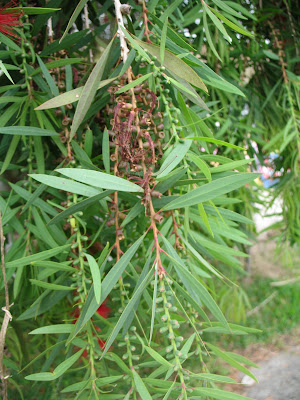This term can be used in reference to 3 main things:







a blog of questions and answers...
This term can be used in reference to 3 main things:







Posted by Rebecca at 8:00 AM 0 comments
Labels: arrangements, florida, flower cluster, inflorescence, patterns, plant i.d., south carolina, terminology, tuesday
Featured Plant:
Name: Callistemon viminalis (Weeping bottlebrush)





Posted by Rebecca at 8:00 AM 0 comments
Labels: bottlebrush, cornus florida, large shrub, linear leaves, long stamens, myrtaceae, pendulous, plant i.d., red flowers, small tree, weeping
Featured Plant:



Posted by Rebecca at 2:38 PM 0 comments
Labels: frangrance, lantana, orange, pink flowers, plant feature, plant i.d., summer annual, summer perennial, woody shrub, yellow flowers
 This is one of my favorite nostalgic roses, and a real Southern beauty it is! In the Pacific Northwest they are few and far between, but I am finding an abundance of these beautiful roses here in the Southeast. The lack of constant drizzling rain here contributes to their stunning spring display. Unlike the more popular repeat bloomers this variety only blooms once, and we are seeing them at their peak right now. I just love those small creamy yellow blooms covering the fine textured branches of this rambling climber. Enjoy!
This is one of my favorite nostalgic roses, and a real Southern beauty it is! In the Pacific Northwest they are few and far between, but I am finding an abundance of these beautiful roses here in the Southeast. The lack of constant drizzling rain here contributes to their stunning spring display. Unlike the more popular repeat bloomers this variety only blooms once, and we are seeing them at their peak right now. I just love those small creamy yellow blooms covering the fine textured branches of this rambling climber. Enjoy! 


Posted by Rebecca at 2:35 PM 0 comments
Labels: charleston, climber, lady banks, plant i.d., rose, south carolina, spring blooms, yellow flowers



Identification:
Posted by Rebecca at 8:00 AM 1 comments
Labels: charleston, fragrant flowers, pittosporum, plant I.D. service, small tree, south carolina, southeast, white flower, woody shrub, yellow flowers
Provided Information:



Identification:
Posted by Rebecca at 8:00 AM 1 comments
Labels: amaryllis, bulb, Georgia, home garden, plant i.d., red flower, southeast, spring blooms
This word may describe the entire plant habit or any specific plant part.



Posted by Rebecca at 8:00 AM 1 comments
Labels: drooping, pendulous, plant i.d., terminology, tuesday, weeping
Featured Plant:




Posted by Rebecca at 8:54 PM 0 comments
This term is usually in reference to the entire plant as a whole, but may also be used to describe individual plant parts. Use the root word 'herb' as a reminder of what this word means. Herbs are generally thought of as being soft and flexible (though some are woody, to be sure).



Posted by Rebecca at 8:00 AM 0 comments
Labels: definitions, herbaceous, plant i.d., terminology, tuesday





Posted by Rebecca at 3:50 PM 0 comments
Labels: fall color, flowering pear, ornamental pear, pyrus calleryana, spring blooms, white flowers
The dogwoods are still blooming, but browning fast as other flowering trees take the spotlight. Here are some dogwood flowers that can be enjoyed any time of the year:

Posted by Rebecca at 8:00 AM 0 comments
Labels: botanical art, botanical cake, cornus florida, dogwood, saturday fun, vanilla orchid cakes


Posted by Rebecca at 11:37 AM 1 comments
Labels: fragrant, hamamelis, i.d., winter blooms, witch hazel, woody shrub, yellow flowers
Provided Information:

Identification:
Posted by Rebecca at 8:00 AM 2 comments
Labels: annual, biennial, flowering kale, Oregon, ornamental kale, plant i.d., winter landscape
Featured Plant:




Posted by Rebecca at 8:00 AM 0 comments
Labels: cercis canadensis, cordate, eastern redbud, heart, legume family, pea family, pink flowers, plant feature, plant i.d., spring blooms
